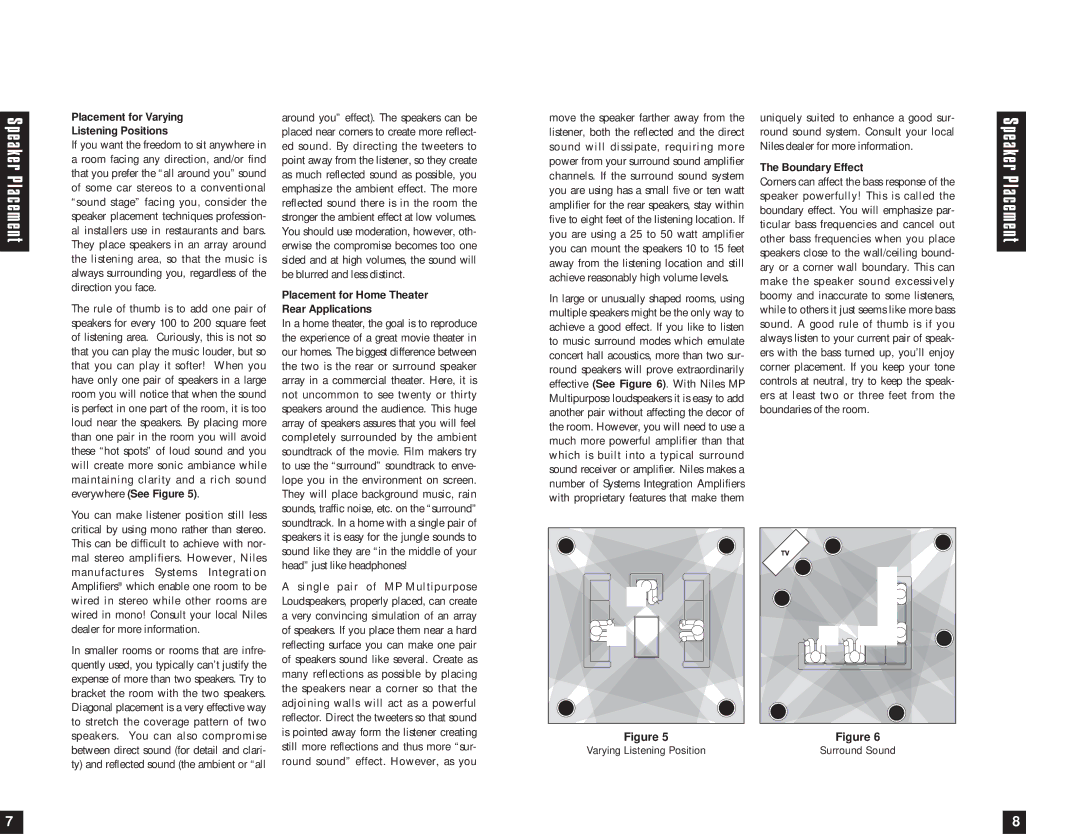
Speaker Placement
Placement for Varying
Listening Positions
If you want the freedom to sit anywhere in a room facing any direction, and/or find that you prefer the “all around you” sound of some car stereos to a conventional “sound stage” facing you, consider the speaker placement techniques profession- al installers use in restaurants and bars. They place speakers in an array around the listening area, so that the music is always surrounding you, regardless of the direction you face.
The rule of thumb is to add one pair of speakers for every 100 to 200 square feet of listening area. Curiously, this is not so that you can play the music louder, but so that you can play it softer! When you have only one pair of speakers in a large room you will notice that when the sound is perfect in one part of the room, it is too loud near the speakers. By placing more than one pair in the room you will avoid these “hot spots” of loud sound and you will create more sonic ambiance while maintaining clarity and a rich sound everywhere (See Figure 5).
You can make listener position still less critical by using mono rather than stereo. This can be difficult to achieve with nor- mal stereo amplifiers. However, Niles manufactures Systems Integration Amplifiers® which enable one room to be wired in stereo while other rooms are wired in mono! Consult your local Niles dealer for more information.
In smaller rooms or rooms that are infre- quently used, you typically can’t justify the expense of more than two speakers. Try to bracket the room with the two speakers. Diagonal placement is a very effective way to stretch the coverage pattern of two speakers. You can also compromise between direct sound (for detail and clari- ty) and reflected sound (the ambient or “all
around you” effect). The speakers can be placed near corners to create more reflect- ed sound. By directing the tweeters to point away from the listener, so they create as much reflected sound as possible, you emphasize the ambient effect. The more reflected sound there is in the room the stronger the ambient effect at low volumes. You should use moderation, however, oth- erwise the compromise becomes too one sided and at high volumes, the sound will be blurred and less distinct.
Placement for Home Theater Rear Applications
In a home theater, the goal is to reproduce the experience of a great movie theater in our homes. The biggest difference between the two is the rear or surround speaker array in a commercial theater. Here, it is not uncommon to see twenty or thirty speakers around the audience. This huge array of speakers assures that you will feel completely surrounded by the ambient soundtrack of the movie. Film makers try to use the “surround” soundtrack to enve- lope you in the environment on screen. They will place background music, rain sounds, traffic noise, etc. on the “surround” soundtrack. In a home with a single pair of speakers it is easy for the jungle sounds to sound like they are “in the middle of your head” just like headphones!
A single pair of MP Multipurpose Loudspeakers, properly placed, can create a very convincing simulation of an array of speakers. If you place them near a hard reflecting surface you can make one pair of speakers sound like several. Create as many reflections as possible by placing the speakers near a corner so that the adjoining walls will act as a powerful reflector. Direct the tweeters so that sound is pointed away form the listener creating still more reflections and thus more “sur- round sound” effect. However, as you
move the speaker farther away from the listener, both the reflected and the direct sound will dissipate, requiring more power from your surround sound amplifier channels. If the surround sound system you are using has a small five or ten watt amplifier for the rear speakers, stay within five to eight feet of the listening location. If you are using a 25 to 50 watt amplifier you can mount the speakers 10 to 15 feet away from the listening location and still achieve reasonably high volume levels.
In large or unusually shaped rooms, using multiple speakers might be the only way to achieve a good effect. If you like to listen to music surround modes which emulate concert hall acoustics, more than two sur- round speakers will prove extraordinarily effective (See Figure 6). With Niles MP Multipurpose loudspeakers it is easy to add another pair without affecting the decor of the room. However, you will need to use a much more powerful amplifier than that which is built into a typical surround sound receiver or amplifier. Niles makes a number of Systems Integration Amplifiers with proprietary features that make them
Figure 5
Varying Listening Position
uniquely suited to enhance a good sur- round sound system. Consult your local Niles dealer for more information.
The Boundary Effect
Corners can affect the bass response of the speaker powerfully! This is called the boundary effect. You will emphasize par- ticular bass frequencies and cancel out other bass frequencies when you place speakers close to the wall/ceiling bound- ary or a corner wall boundary. This can make the speaker sound excessively boomy and inaccurate to some listeners, while to others it just seems like more bass sound. A good rule of thumb is if you always listen to your current pair of speak- ers with the bass turned up, you’ll enjoy corner placement. If you keep your tone controls at neutral, try to keep the speak- ers at least two or three feet from the boundaries of the room.
Figure 6
Surround Sound
Speaker Placement
7 |
| 8 |
|
|
|
